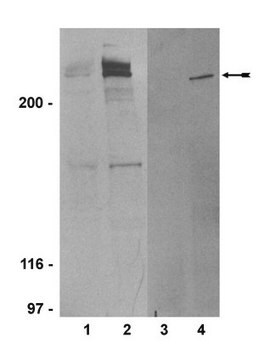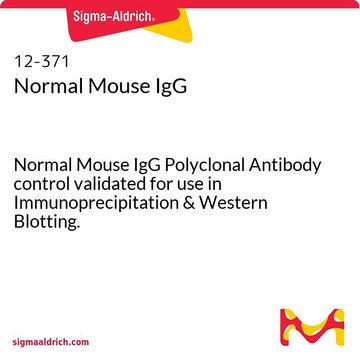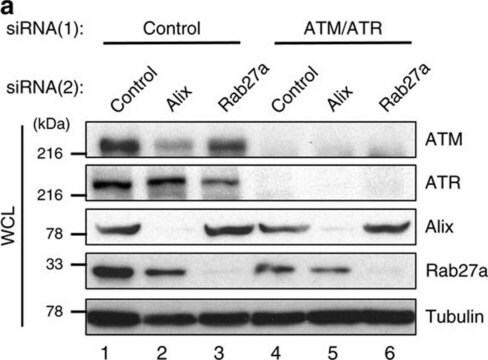MAB3806-C
Anti-phospho-ATM (Ser1981) Antibody, clone 10H11.E12, Ascites Free
clone 10H11.E12, from mouse
Synonyme(s) :
Serine-protein kinase ATM, Ser1981 phosphorylated, Ataxia telangiectasia mutated, Ser1981 phosphorylated, A-T mutated, Ser1981 phosphorylated
About This Item
Produits recommandés
Source biologique
mouse
Niveau de qualité
Forme d'anticorps
purified immunoglobulin
Type de produit anticorps
primary antibodies
Clone
10H11.E12, monoclonal
Espèces réactives
mouse, human
Technique(s)
ELISA: suitable
immunocytochemistry: suitable
immunoprecipitation (IP): suitable
western blot: suitable
Isotype
IgG1κ
Numéro d'accès NCBI
Numéro d'accès UniProt
Conditions d'expédition
wet ice
Modification post-traductionnelle de la cible
phosphorylation (pSer1981)
Informations sur le gène
human ... ATM(472)
Description générale
Spécificité
Immunogène
Application
ELISA Analysis: a representative lot was employed as the capture antibody for the detection of interaction between EphA5 and Ser1981-phosphorylated ATM. ATM pSer1981 captured from NCI-H460 human lung cancer cell extracts interacted with recombinant EphA5 cytoplasmic domain, but not with EphA5 extracellular domain or kinase domain (Staquicini, F.I., et al. (2015). J. Biol. Chem. 290(12):7345-7359).
Immunocytochemistry Analysis: A representative lot detected radiation-/IR-induced upregulation of nuclear ATM pSer1981 foci by fluorescent immunocytochemistry staining of methanol-fixed NCI-H460 human lung cancer cells (Staquicini, F.I., et al. (2015). J. Biol. Chem. 290(12):7345-7359).
Immunocytochemistry Analysis: A representative lot detected radiation-/IR-induced ATM Ser1981 phosphorylation by fluorescent immunocytochemistry staining of 1.2% formaldehyde-fixed, 0.1% Triton X-100-permeabilized HT29 cells (Bardelle, C., and Boros, J. (2012). J. Biomol. Screen. 17(7):912-920).
Immunocytochemistry Analysis: A representative lot detected ionizing radiation-/IR-induced ATM Ser1981 phosphorylation by fluorescent immunocytochemistry staining of methanol/acetone-fixed primary human foreskin fibroblasts (HFFs) (Bakkenist, C.J., et al. (2004). Cancer Res. 64(11):3748-3752).
Western Blotting Analysis: A representative lot detected epirubicin-induced ATM Ser1981 (Ser1987 in mouse) phosphorylation in mouse embryonic fibroblasts (MEFs) and human MCF-7 cells (Khongkow, P., et al. (2014). Oncogene. 33(32): 4144-4155).
Western Blotting Analysis: A representative lot detected camptothethin-induced ATM Ser1987 (Ser1981 in human) phosphorylation in primary mouse cortical neurons (Brochier, C., et al. (2013). J. Neurosci. 33(20): 8621-8632).
Western Blotting Analysis: A representative lot detected radiation-/IR-induced ATM Ser1981 phosphorylation in HT29, HeLa, and HEK293T cells (Bardelle, C., and Boros, J. (2012). J. Biomol. Screen. 17(7):912-920).
Western Blotting Analysis: A representative lot detected ionizing radiation-/IR-induced ATM Ser1981 phosphorylation in U2OS cells by Western blotting using whole cell lyates or B56γ immunoprecipitate (Shouse, G.P., et al. (2011). Oncogene. 30(35):3755-3765).
Western Blotting Analysis: A representative lot detected ionizing radiation-/IR-induced ATM Ser1981 phosphorylation in cultured primary human foreskin fibroblasts (HFFs), as well as passage-dependent basal ATM Ser1981 phosphorylation levels in HFFs (Bakkenist, C.J., et al. (2004). Cancer Res. 64(11):3748-3752).
Epigenetics & Nuclear Function
Cell Cycle, DNA Replication & Repair
Qualité
Immunocytochemistry Analysis: 4.0 µg/mL of this antibody detected Camptothecin (Cat. No. 208925) treatment-induced increase of nuclear ATM pSer1981 foci in HeLa cells.
Description de la cible
Forme physique
Stockage et stabilité
Autres remarques
Clause de non-responsabilité
Vous ne trouvez pas le bon produit ?
Essayez notre Outil de sélection de produits.
En option
Code de la classe de stockage
12 - Non Combustible Liquids
Classe de danger pour l'eau (WGK)
WGK 1
Point d'éclair (°F)
Not applicable
Point d'éclair (°C)
Not applicable
Certificats d'analyse (COA)
Recherchez un Certificats d'analyse (COA) en saisissant le numéro de lot du produit. Les numéros de lot figurent sur l'étiquette du produit après les mots "Lot" ou "Batch".
Déjà en possession de ce produit ?
Retrouvez la documentation relative aux produits que vous avez récemment achetés dans la Bibliothèque de documents.
Notre équipe de scientifiques dispose d'une expérience dans tous les secteurs de la recherche, notamment en sciences de la vie, science des matériaux, synthèse chimique, chromatographie, analyse et dans de nombreux autres domaines..
Contacter notre Service technique








